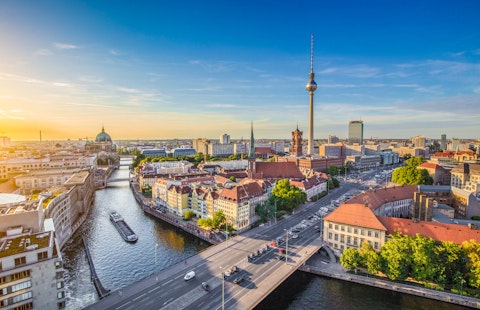In this article, we’ll list the most advanced countries to discuss their economic and human development status. For a shorter list, you can go to 10 Most Developed Countries in the World Heading into 2024.
The distinction between developing and developed countries is multifaceted, encompassing economic, social, and infrastructural elements. Countries with developed economies are characterized by significant per capita incomes, advanced industrial sectors, robust infrastructure, and business-friendly environments. The Human Development Index (HDI) is a critical measure of a country’s progress, assessing average achievements in key areas such as health and longevity, education, and standard of living. The World Bank classifies countries based on Gross National Income (GNI) per capita, designating those with a GNI above US$12,695 as high-income.
Economically developed countries boast well-established service sectors that significantly contribute to their GDP. These countries often enjoy high standards of living, evident in life expectancy, education quality, healthcare, and access to advanced technologies. Their labor markets are inclusive, with high minimum wage standards. These countries also benefit from comprehensive education and healthcare systems. Thanks to a sound financial structure, they experience high urban development, widespread access to food and clean water, established manufacturing and service industries, consistent economic growth (typically between 2% and 4%), and low rates of extreme poverty.
In contrast, developing and underdeveloped countries are generally more reliant on agriculture and have lower living standards, informal industrial sectors, weaker infrastructure, less efficient government institutions, and a less favorable business climate.
Check the other side of the world’s wealth distribution by reading 40 Least Developed Countries in the World Heading into 2024.
A Favorable Business Climate in Developed Countries
Developed countries earn and maintain their status through systematic efforts, among which a favorable business climate is key. This environment facilitates economic growth by attracting investments and enhancing competitiveness.
Most economically developed countries rank high in the ease of doing business, indicating that their regulatory environments are conducive to starting and operating local firms. This is a key factor in their ability to nurture profitable businesses.
Consider Singapore, which is consistently ranked at the top of the World Bank’s Ease of Doing Business Index. Its economic strength is largely due to its efficient regulatory environment. Starting a business in Singapore is straightforward, with minimal bureaucratic obstacles. Additionally, Singapore’s tax system is business-friendly, boasting one of the world’s lowest corporate tax rates and various incentives for startups and foreign investors. A prime example is Wilmar International, Asia’s leading agribusiness group. Founded in 1991, the company now operates over 1,000 manufacturing plants and has a vast distribution network in 50 countries and regions. Moreover, besides local companies, Singapore is the go-to destination for multinational companies’ Asian headquarters.
Coca-Cola Co (NYSE:KO) is a notable example of this. Headquartered in the US, the company operates a regional headquarters in Singapore, which oversees its operations across the Asia Pacific region. Coca-Cola’s Asia Pacific segment now encompasses 37 markets, catering to over 3.3 billion consumers. This contributes to an industry retail value of $475 billion in the region, surpassing the combined retail market value of North and South America. Notably, in FY 2022, the Asia Pacific region accounted for 24% of the company’s sales. This follows Europe, MENA, and Africa’s combined share of 28% and Latin America’s 27%.
Employing over 700,000 people worldwide, along with its 200 bottling partners, Coca-Cola Co (NYSE:KO) exemplifies how companies can expand their reach due to favorable business environments. Other major corporations, like McDonald’s, Nestle, PepsiCo, and Unilever, benefit from strong financial climates in their home countries, like Coca-Cola Co (NYSE:KO), and then create vast employment networks and enter new markets, further benefiting local economies.
You can read more about such companies in 25 Countries with the Lowest Unemployment Rates in the World.

35 Most Developed Countries in the World Heading into 2024
Our Methodology
We shortlisted the most developed countries in the world heading into 2024 by considering their Human Development Index scores and GDPs per capita. To form our final list, we first ranked these countries based on their standing in the Human Development Index of 2021-2022 and then separately ranked them on their GDPs per capita. Later, we averaged these two rankings for all countries and graded them in descending order of their average rankings.
As per our findings, here are the most prosperous countries in the world:
35. Poland
HDI Ranking: 34
GDP Per Capita: $18,321
Composite Score: 35
In 2023, Poland’s economy experienced mixed results, achieving a significant 4.9% GDP growth in 2022 but facing slower economic activity thereafter, according to the US Department of State. This slowdown is attributed to high inflation, the ongoing impact of Russia’s invasion of Ukraine, and decreased demand from key trading partners. In response, the Polish government has implemented measures like the Anti-Inflationary Shield and the Energy Shield to mitigate these issues.
34. Greece
HDI Ranking: 33
GDP Per Capita: $20,732
Composite Score: 34
Greece has recently enjoyed robust economic growth, surpassing the European average. This positive trend is expected to continue, with growth forecasts of 2.9% in 2024, up from 2.4% in 2023. After overcoming significant economic challenges, including two major downturns, Greece reached its highest position yet on the global Legatum Prosperity Index, securing 40th place in 2023. The Legatum Prosperity Index measures countries’ prosperity beyond traditional economic indicators, considering factors that contribute to residents’ overall well-being and quality of life.
33. Czech Republic
HDI Ranking: 32
GDP Per Capita: $27,634
Composite Score: 33
As 2024 approaches, the Czech Republic presents a dynamic yet complex economic and developmental landscape. Ranked 25th globally in overall prosperity, the country shows strengths in safety, security, and economic quality. In 2023, IMF had noted that the Czech Republic experienced an economic downturn, marked by a slight GDP contraction due to reduced household spending and falling real wages. However, forecasts for 2024 are more optimistic, anticipating an economic revival driven by improvements in domestic consumption and investment.
Also Read: 50 Most Populated Countries in 2030
32. Bahrain
HDI Ranking: 35
GDP Per Capita: $30,152
Composite Score: 32
Bahrain’s economic landscape in 2024 reflects robust growth. The country’s GDP peaked at $34 billion in 2022 and 2023, the highest in over a decade, driven largely by the expansion of its non-oil sector and increased private sector contributions. In 2022, Bahrain’s economy expanded by 4.9%, with a 6.2% increase in non-oil GDP, marking the fastest growth rate in ten years. This expansion, fueled by a surge in non-oil GDP, underscores the success of fiscal reforms and the beneficial effects of high oil prices. However, a moderate growth rate of 2.7% is anticipated by the end of 2023, with projections suggesting a stabilization of economic growth.
31. Estonia
HDI Ranking: 31
GDP Per Capita: $28,332
Composite Score: 31
Estonia, with a population of approximately 1.3 million, adopts a forward-thinking approach to digitalization, evident in its advanced public digital services, such as electronic voting and tax filing. The country’s investment-friendly tax system exempts reinvested and retained profits from income tax and applies a flat tax rate to individual incomes. Despite its innovations, Estonia has faced global economic challenges, including the conflict in Ukraine, rising inflation, and supply chain issues. In response to Russia’s invasion of Ukraine in February 2022, Estonia ceased all energy imports from Russia, culminating in a legally binding sanction in December 2022.
30. Spain
HDI Ranking: 27
GDP Per Capita: $29,350
Composite Score: 30
As Spain approaches 2024, its economic landscape features a mix of growth and challenges. Driven by the services sector and tourism, the economy is expected to grow moderately, with a projected 3% reduction in the public deficit in 2024. The unemployment rate is expected to decrease, reflecting a stronger job market and improved employment rate. However, Spain faces the challenge of high inflation, particularly in food prices, and the impacts of global geopolitical events. Government measures to address inflation and the cost-of-living crisis offer short-term relief but pose implications for public finances.
29. Cyprus
HDI Ranking: 29
GDP Per Capita: $31,283
Composite Score: 29
Cyprus has demonstrated economic resilience, ranking among the top ten EU countries in growth rate for 2023 and 2024. However, the growth rate slowed from 5.6% in 2022 to 2.3% in 2023, with a slight rebound to 2.7% expected in 2024, reports CBN. This slowdown is due to high inflation affecting household purchasing power, higher interest rates impacting investment, and weaker growth in trading partners. Despite these challenges, sectors like tourism and export-oriented services are projected to continue growing, albeit more slowly. The labor market is improving, with unemployment decreasing to 6.8% in 2022, though a slight increase to 6.9% is anticipated in 2023.
28. Italy
HDI Ranking: 30
GDP Per Capita: $34,158
Composite Score: 28
In 2023, Italy exhibited resilience and potential in the face of global economic challenges, achieving a 3.7% GDP growth in 2022. This resilience is partly due to government policies focusing on growth, welfare, and the sustainability of public accounts. Key objectives include supporting families and businesses, stimulating investment, and gradually reducing deficit and debt. The government also projects a decrease in the debt-to-GDP ratio from 144% in 2022 to 140.4% in 2026, with a concurrent reduction in the deficit. Additionally, Italy’s startup ecosystem is thriving, with a significant 879% growth in innovative startups from 2013 to 2022, as noted by the Rome Business School.
27. Slovenia
HDI Ranking: 24
GDP Per Capita: $29,457
Composite Score: 27
Slovenia has shown economic recovery, particularly following the epidemic, supported by expansionary fiscal policies. In 2022, the GDP per capita in purchasing power standards reached 92% of the EU average, the highest level ever recorded for the country. However, Slovenia faces a productivity development gap, standing at 86% of the EU average in 2022. This gap results from the slow pace of smart and green transformation, with low investment levels in R&D, ICT, and machinery and equipment. Notably, Slovenia ranked 33rd globally in the 2023 Global Innovation Index, which measures and compares countries’ innovation performance.
26. France
HDI Ranking: 28
GDP Per Capita: $40,963
Composite Score: 26
As we head into 2024, France’s economic landscape shows signs of gradual growth, labor market improvements, and fiscal challenges. The country’s economic growth is anticipated to conclude at 0.7% in 2023, a marginal increase from earlier predictions. Additionally, employment trends in France are positive, with an expected increase in job creation and a decrease in unemployment. By 2025, the unemployment rate is projected to reach approximately 7.6%, lower than pre-pandemic levels.
25. Malta
HDI Ranking: 23
GDP Per Capita: $33,940
Composite Score: 25
Malta’s economy in 2022 was characterized by strong employment growth, with a 6% increase in both public and private sectors. This growth led to a decrease in the unemployment rate, which fell to 2.9% in 2022 and is expected to remain stable in the coming years. Furthermore, the country’s economy is predicted to grow by 3.7% in 2023, reflecting its rapid recovery in 2022.
24. Republic of Korea (South Korea)
HDI Ranking: 20
GDP Per Capita: $32,254
Composite Score: 24
South Korea’s transformation into a developed country is marked by significant economic and technological advancement. Since the 1950s, when its per capita income was just US$67, the country has achieved an average annual GDP growth rate of 4.9% from 1988 to 2022. This growth elevated its gross national income per capita to US$32,661 by 2022. South Korea’s rapid development earned it the recognition of a high-income economy and a leader in innovation and technology, transitioning from an aid recipient to a member of the OECD’s Development Assistance Committee.
Also Read: 25 Countries that Give the Most Foreign Aid Per Capita
23. Japan
HDI Ranking: 19
GDP Per Capita: $33,815
Composite Score: 23
Japan’s development and prosperity in 2023 can be attributed to several factors, though it faces challenges as well. The country’s real GDP growth was projected at +2.1% for the fiscal year 2023, indicating economic recovery despite issues such as high prices and a weak yen in the previous year. Notably, Japan’s industrial sector, especially the motor vehicle industry, has shown adaptability. As of June 2023, industrial production indices rose due to increased production of vehicle parts, reflecting the sector’s capacity to respond to challenges.
22. United Arab Emirates
HDI Ranking: 26
GDP Per Capita: $53,757
Composite Score: 22
The UAE’s economic strategy, focused on diversifying beyond oil, has proven successful, with its GDP reaching Dh1.62 trillion ($442 billion) in 2022, primarily driven by non-oil sector growth. This surge underscores the country’s commitment to developing an innovative and future-oriented economic model marked by dynamic policies, diversification, and sustainable growth. The UAE’s advancements in infrastructure and resource management have been recognized in 5 global indices related to energy, water, infrastructure, and transport in 2023.
21. Austria
HDI Ranking: 25
GDP Per Capita: $52,131
Composite Score: 21
As 2024 approaches, Austria continues to show resilience in its economy despite facing global challenges such as high energy costs and geopolitical tensions. Although a slight recession was forecasted at the end of 2022 and early 2023, Austria’s GDP is still expected to grow modestly.
20. United Kingdom
HDI Ranking: 18
GDP Per Capita: $45,850
Composite Score: 20
In 2023, the United Kingdom faces a crucial juncture, navigating between maintaining its global influence and addressing domestic challenges that necessitate significant reforms and innovative solutions. To combat declining living standards and growing economic inequality, the country’s economic strategy requires evolution. Essential measures include prioritizing the services sector in trade policies, increasing transportation infrastructure investments in major urban areas, and addressing the relatively low public investment levels compared to other G7 countries.
19. Israel
HDI Ranking: 22
GDP Per Capita: $54,659
Composite Score: 19
In 2022, Israel’s economy grew impressively at 6.5%, driven largely by its dynamic tech sector and a historic low in unemployment, currently at 3.6%. However, this rapid growth is expected to slow to around 2.5% in 2023 due to a decrease in household spending and cautious business investments. Israel’s economic resilience is largely due to its robust high-tech industry, which is globally recognized for innovation. The country boasts over 6,000 tech startups and leads in startups per capita, supported by significant local and international investments.
18. New Zealand
HDI Ranking: 14
GDP Per Capita: $48,249
Composite Score: 18
New Zealand is crowned one of the best countries in the world because of its accepting culture, which makes it attractive for immigrants. However, the country’s economic growth is slowing following a period of strong performance. This is partly due to the Reserve Bank’s efforts to control inflation and strong domestic demand by raising interest rates. Despite this, the economy is expected to recover gradually, supported by sectors like tourism and net migration. The unemployment rate, expected to temporarily peak at 5.3% by late 2024, is projected to stabilize over the long term.
17. Belgium
HDI Ranking: 13
GDP Per Capita: $49,582
Composite Score: 17
Belgium’s economy is growing at a rate of 1.4% in 2023 and is expected to stabilize at similar levels in the coming years. The job market remains robust, with unemployment consistently below 6%. This reflects a healthy employment sector despite a labor shortage that could impact future economic growth. Although the rate of job creation is likely to slow slightly in the short term, the unemployment rate is expected to remain stable or decrease slightly by 2025.
16. Germany
HDI Ranking: 9
GDP Per Capita: $48,432
Composite Score: 16
Germany is among the top developed countries, with a strong industrial base and status as a leading exporter in the automotive and machinery sectors. In 2023, however, Germany’s economy faces a downturn, with a projected GDP contraction of 0.6%, due to rising energy prices, high inflation, and the impact of the Russia-Ukraine conflict. Germany is also a significant player in international development aid, but there are concerns about potential funding cuts for long-term development initiatives in 2024, which could affect its global humanitarian role.
15. United States
HDI Ranking: 21
GDP Per Capita: $79,398
Composite Score: 15
In 2023, the United States economy continues to grow, albeit moderately, with Deloitte projecting a growth rate of around 1.5% to 1.6% by 2025, while inflation is expected to moderate to below 3% in the same period. This growth occurs despite risks such as stringent monetary policies and market sensitivities. Notable during this period is the stabilization of inflation rates and a stable job market, indicating a balanced economic trajectory.
14. Canada
HDI Ranking: 15
GDP Per Capita: $54,966
Composite Score: 14
In early 2023, Canada’s economy displayed resilience, bolstered by stable population growth and a strong labor market. These factors were key in navigating global economic fluctuations. However, mid-2023 saw a slowdown, with sectors like construction and retail experiencing declines. These were partly balanced by increases in real estate activity and factory output. Notably, residential construction significantly decreased, affected by higher financing costs and falling approximately 30% below its peak in spring 2021.
13. Finland
HDI Ranking: 11
GDP Per Capita: $50,536
Composite Score: 13
The Finnish economy faced challenges in 2023, with projections pointing towards a recession due to the energy crisis and rising living costs. The GDP was expected to contract slightly, reflecting the effects of high inflation and reduced purchasing power on consumer behavior and business investment. Despite these challenges, Finland’s GDP per capita and human development levels remain among the highest, securing its position as one of the most developed countries in the world heading into 2024.
12. Hong Kong (SAR)
HDI Ranking: 4
GDP Per Capita: $48,983
Composite Score: 12
Hong Kong is focusing on expanding into new areas such as the digital economy, green technology, and Web3. This strategy is supported by its unique “one country, two systems” framework, enabling it to leverage support from mainland China while maintaining global economic ties. Notably, the Hong Kong International Airport ranks among the world’s busiest for international air cargo, underscoring the region’s critical role in global trade and logistics.
11. Netherlands
HDI Ranking: 10
GDP Per Capita: $55,985
Composite Score: 11
The Netherlands has shown remarkable economic resilience, especially in terms of GDP per capita growth, which currently stands at $55,985. In 2022, the country’s GDP per capita growth was 3.5%, exceeding the growth rates of major European Union partners like Germany, Belgium, and France. However, 2023 presented challenges for the Dutch economy, with slower economic growth estimated at just 0.4%.
Click to continue reading 10 Most Developed Countries in the World Heading into 2024.
Suggested Articles:
- Top 20 Most Underdeveloped Countries In The World In 2023
- 30 Least Developed Countries in the World and Funds that Invest in Them
- Top 20 Countries With Most Natural Resources in the World
Disclosure: None. 35 Most Developed Countries in the World Heading into 2024 is originally published at Insider Monkey.





